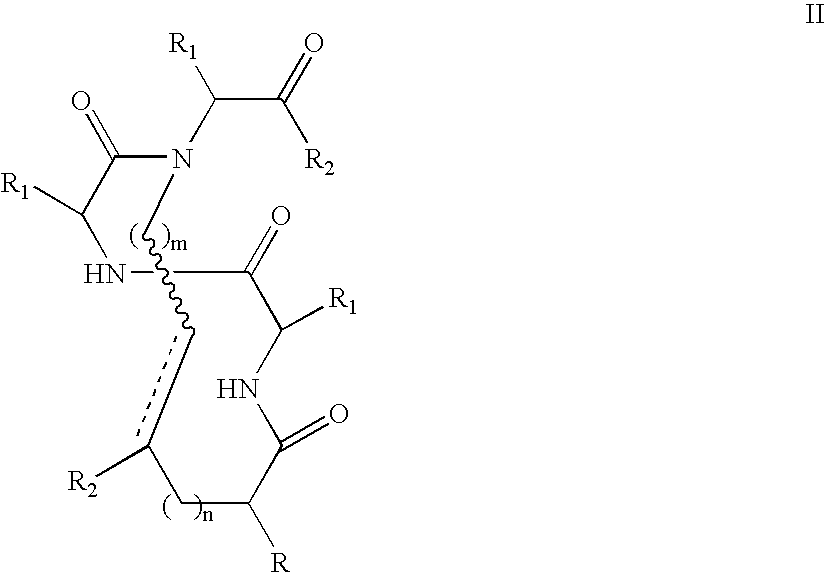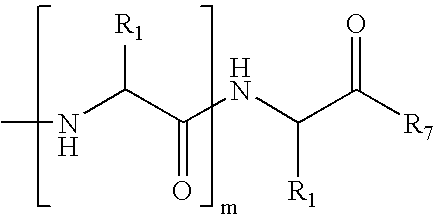Methods for preparing internally constrained peptides and peptidomimetics
a technology of peptides and peptides, applied in the direction of peptides, peptide/protein ingredients, immunoglobulins, etc., can solve the problem of blocking the solvent-exposed surface of the target, and achieve the effects of promoting cell death, promoting cell death, and promoting cell death
- Summary
- Abstract
- Description
- Claims
- Application Information
AI Technical Summary
Benefits of technology
Problems solved by technology
Method used
Image
Examples
example 1
Synthesis of an Internally-Constrained α-Helix
[0084] To test the stabilization properties of the metathesis-derived internal crosslinks, an 8-mer constrained peptide 3 bearing a crosslink at the N-terminus was synthesized as shown in Scheme 4. This particular peptide was chosen because the control peptide 1 (AcGEAAAAEA-OMe (SEQ ID NO: 35)) does not display any α-helicity, thus allowing for an observation of an increase in α-helical content following the modification. Two glutamic acid residues were incorporated in this alanine-rich peptide at different faces of the putative helix to increase the solubility of the constrained peptide in aqueous buffers. The metathesis precursor peptide 2 underwent a ring-closing metathesis reaction with Hoveyda-Grubbs metathesis catalyst (Hoveyda et al., “Ru Complexes Bearing Bidentate Carbenes: From Innocent Curiosity to Uniquely Effective Catalysts for Olefin Metathesis,”Org. Biomolec. Chem. 2:8-23 (2004), which is hereby incorporated by reference...
example 2
Preparation of Other Peptidomimetics
[0109]FIG. 11 shows common peptide secondary structures. These secondary structures are defined by hydrogen-bonding patterns, as demonstrated in FIG. 12. As shown in Scheme 8, the peptide modification methodology of the present invention not only allows preparation of artificial α-helices, but also of β-sheets / β-turns, 310-helices, and α-helices. These secondary structures may be prepared with the RCM method or the alkylation / macrocyliziation strategy as discussed previously for internally-constrained α-helices.
example 3
Stabilization of BAK BH3 α-Helical Region
[0110] Example 1 demonstrates that the hydrogen-bond surrogate approach of the present invention affords highly stable α-helices from alanine-rich peptide sequences. This Example demonstrates the use of the hydrogen bond-surrogate approach of the present invention for the stabilization of biologically-relevant α-helices. This method can effectively stabilize α-helical conformations in non-alanine rich sequences. The resulting molecules resist proteolytic degradation as compared to their unconstrained analogs and bind their protein targets with high affinity.
Bak BH3
[0111] Bcl-xL is an extensively studied α-helix binding protein (Sattler et al., Science 275:983-986 (1997), which is hereby incorporated by reference in its entirety). Bcl-xL is an anti-apoptotic protein that regulates cell death by binding the α-helical BH3 domain of a family of pro-apoptotic proteins (such as Bak, Bad, Bid, and Bax) (Cory et al., Oncogene, 22:8590-8607 (2003)...
PUM
| Property | Measurement | Unit |
|---|---|---|
| temperature | aaaaa | aaaaa |
| temperature | aaaaa | aaaaa |
| temperature | aaaaa | aaaaa |
Abstract
Description
Claims
Application Information
 Login to View More
Login to View More - R&D
- Intellectual Property
- Life Sciences
- Materials
- Tech Scout
- Unparalleled Data Quality
- Higher Quality Content
- 60% Fewer Hallucinations
Browse by: Latest US Patents, China's latest patents, Technical Efficacy Thesaurus, Application Domain, Technology Topic, Popular Technical Reports.
© 2025 PatSnap. All rights reserved.Legal|Privacy policy|Modern Slavery Act Transparency Statement|Sitemap|About US| Contact US: help@patsnap.com



